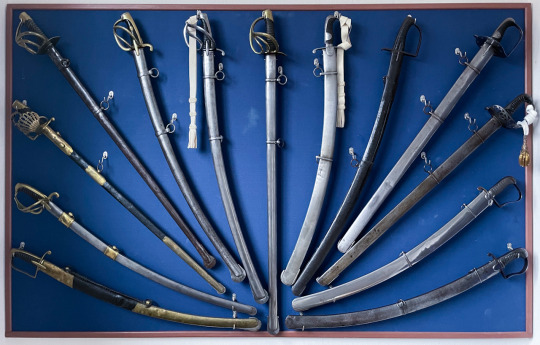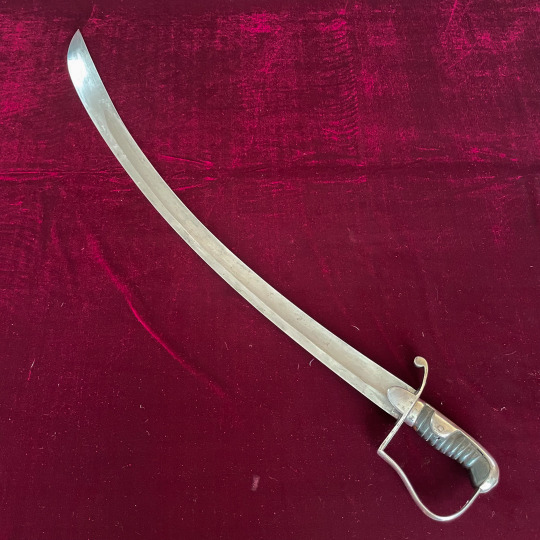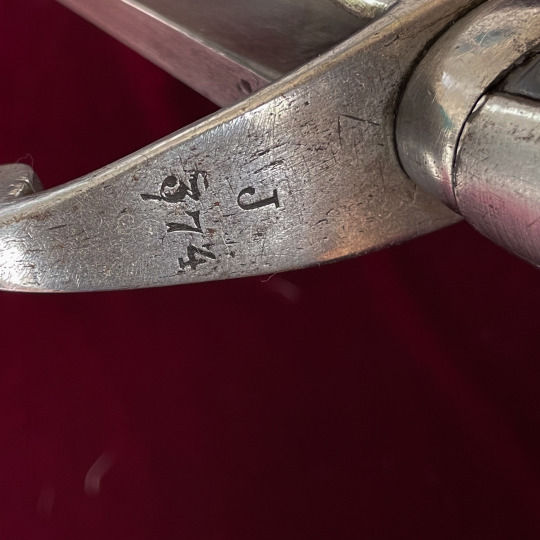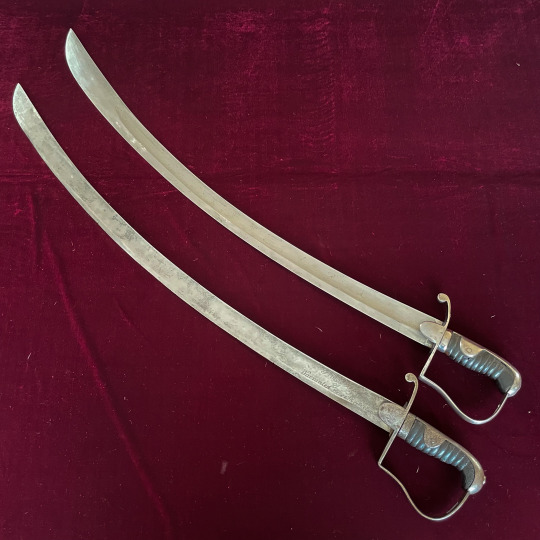#Dutch swords
Explore tagged Tumblr posts
Photo

Another re-shuffle of the sword wall. I swapped out the 1796 Pattern heavy cavalry officers dismounted service sword for the 1796 Pattern heavy cavalry officers undress sword. I think this is more in keeping with the other swords which are all trooper swords or officer’s service swords.
The new composition is (from left to right):
- Dutch m1800 Light Cavalry officer’s or NCO’s sabre - French An XI Light Cavalry officer’s sabre - French ‘Garde de Bataille’ Dragoon officer’s sword - French An XIII Heavy Cavalry troopers’ sword - French An XI Light Cavalry trooprs’ sword - Dutch m1813 No.2 Light Cavalry troopers’ sabre - Dutch m1814 No.3 Heavy Cavalry troopers’ sword - British 1796 Pattern Light Cavalry troopers’ sabre (Dutch issued as the 1813 No.1 for light cavalry) - British 1788 Pattern Light Cavalry troopers’ sabre - British 1796 Pattern Heavy Cavalry troopers’ sword - British 1796 Pattern Heavy Cavalry officer’s undress sword - British 1796 Pattern Light Cavalry yeomanry officer’s sabre - British 1796 Pattern Light Cavalry officer’s sabre
#Swords#British swords#Georgian Era#Napoleonic era#Antiques#French swords#Dutch swords#Cavalry swords
110 notes
·
View notes
Text

"Back for a rematch, little Knightmare?"
(ID: Kirby series fanart of Galacta Knight seated on a cluster of tall, cracked, geometric stone pillars, framed at an angle with crescent-moon-like rock formations rising behind him as well as a starry sky backdrop. He leers down at the viewer through the cross visor of his mask, his feet crossed and his wings spread majestically, his head resting in one hand, the other held out to lazily nudge the end of his lance, which stands pierced through another pillar below him, his shield similarly embedded in a third pillar beside it. Behind his horns shines a brilliant halo of glowing pink Heart Spears, the pale light that radiates from it erupting in rings of soft flares and leaving all surfaces rimmed with sparkles, as beautiful as it is ominous. END ID.)
Started 07/07/24, finished 07/13/24, updated for color correction 11/02/24.
#veins art#veins fanart#kirby series#kirby#galacta knight#kirby super star ultra#so fun fact#this was supposed to be another stress-relief piece#only to quickly turn into a stress-reinforcing piece instead#then I added a Dutch angle and some lens flares#and suddenly I love art again#(for real tho I am VERY proud of this one despite the bumps getting there)#(also I finally figured out how to use the color fader let's gooo)#stars just look at this smug li'l menace#I do love me some Real Bastard Hours GK#(just as much as I love Dumb As Bricks But Ultimately Means Well GK)#I'm also just now realizing that energy swords might've been a better choice for the halo considering it's regular GK and not Aeon Hero...#oh well too late now - heart spear halo go brrr#eye contact tw#veinsfullofstars
732 notes
·
View notes
Photo

#art#painting#dutch golden age#vanitas still life#vanitas#skull#books#sword#lute#sea schells#flutes#compass#masterpiece#harmen steenwijck
135 notes
·
View notes
Text

fursona redesign for @tarovarne
#furry#furry art#art#artists on tumblr#oc#sfw furry#dutch angel dragon#dutchie#dutchie oc#demon#demon oc#bigass sword
159 notes
·
View notes
Text

The Arrest of Christ
Artist: Matthias Stom (Dutch, 1600 – after 1652)
Date: c. 1630-1632
Medium: Oil on Canvas
Collection: National Gallery of Canada, Ottawa, Ontario, Canada
Description
Christ and Judas are dramatically lit by the torch while the other figures emerge from the darkness only where the light catches them. This work was likely painted in Rome, where Stom was inspired by the example of Caravaggio and his followers. Christ's robes would have suggested historic costume to contemporary viewers; in contrast, the men arresting him wear something closer to modern dress. Caravaggio championed anachronism - the violation of historical accuracy - as a means of giving biblical subjects urgency by connecting them to modern life. Significantly, Stom has applied this interpretive freedom only to the secondary figures; Christ's appearance and clothing are traditional. The image is a compound of new and old - Christ's life played out in modern times. Frame: carved and gilded wood. Italy, 17th century.
The Arrest of Jesus | Matthew 26:47-56
Judas arrived with a large crowd armed with swords and clubs and sent by the chief priests and the elders. They were to arrest the man Judas kissed. Judas went straight to Jesus and said, “Peace be with you, Teacher,” and kissed him.
#painting#oil on canvas#matthias stom#dutch painter#dutch art#arrest of christ#biblical story#christianity#crowd#swords#club#judas#christ#night#holy bible#gospel of matthew
10 notes
·
View notes
Text

This sabre is probably my favorite enlisted ranks swords. While the British 1796 Pattern light cavalry sabre is an iconic weapon, the Dutch m1813 No.2 light cavalry troopers sabre fells better in my hand, has a longer blade and more hand protection. Modeled on the French An XI light cavalry sabre, which the armed forces of the newly formed Kingdom of the Netherlands would have retained in significant quantities, 1,000 of these sabres were ordered in February 1814 and another 1,000 in April 1815. A unique Dutch design, these were originally intended for the mounted Artillery and the Artillery train. However there is evidence that these were also used by the Light Dragoons to supplement their British made 1796 Pattern light cavalry sabres, called the m1813 No.1 in Dutch service. Both the m1813 No. 1 and No. 2 sabres were replaced by the m1814 in the middle of the 1820s although they continued to see use with secondary units well into the 1830s. The TT stamp on my example shows that for part of it's service life it was issued to the Artillery Train.
#swords#cavalry#light cavalry#Dutch Army#Napoleonic wars#sabre#m1813 No. 2#napoleonic era#military antiques#antiques
117 notes
·
View notes
Text

Portrait of Prince Willem II (1626-1650
Artist: Workshop of Gerard van Honthorst (Dutch, 1592–1656)
Date: After 1647
Medium: Oil on canvas
Collection: Mauritshuis, The Hague, Netherlands
William II, Prince of Orange
William II (27 May 1626 – 6 November 1650) was sovereign Prince of Orange and Stadtholder of Holland, Zeeland, Utrecht, Guelders, Overijssel and Groningen in the United Provinces of the Netherlands from 14 March 1647 until his death three years later on 6 November 1650. His death marked the beginning of the First Stadtholderless Period, leading to the rise of Johan De Witt, who stayed in power for the next 22 years.
#portrait#man#standing#prince willem ii#prince of orange#stadtholder of holland#dutch golden age#gerard van honthorst#dutch painter#netherlandish#classic pillar#uniform#blue sash#sword#cloudy skys#17th century painting#artwork#oil on canvas#oil painting#seventeen century
8 notes
·
View notes
Text


Style experimenting with Some side characters from my OC verse "anomalies unknown". thought it looked nice without colours as well so put up 2 versions. names from left to right: Sterre Morgan, The sword/Kau de Vries, Niko Kennedy, Carmen Molenaar and Merel Jutter
#Anomalies Unknown (oc verse)#my art#the sword (oc)#sterre morgan (oc)#niko kennedy (oc)#carmen molenaar (oc)#Merel Jutter#the full names are important they have mean puns in them though they're all in dutch#I should open commisions I wonder if people would pay for this style#original characers#cw body horror#cw gore#cw blood#the sword got a bloody mouth in the redesign since I made him based on a colorobètch (belgian folklore monster)
8 notes
·
View notes
Text
rdr2 medieval au
5 notes
·
View notes
Text
The Dutch? Again?!
#broken sword#broken sword shadow of the templars#george stobbart#adam savidan#loadingreadyrun#the whatever thing#the dutch!#lrr
3 notes
·
View notes
Text
youtube
Part two of the video on Swords of the 80 Years War produced by Allemansend Re-enactment.
www.allemansend.com youtube.com/@AllemansendRe-enactment
#Youtube#swords#antiques#military antiques#antique weapons#reenactment#dutch military#military history#17th century#16th century#80 years war
4 notes
·
View notes
Text

Allegory of Peace
Artist: Jan Lievens (Dutch, 1607-1674)
Date: 1652
Medium: Oil on Canvas
Collection: Rijksmuseum, Amsterdam, Netherlands
Description
The painting shows a seated female who represents peace being crowned with a laurel wreath by a woman who is clad in armour who represents war. Under her feet lies a man in armor with a sword, his hands wrapped in chains. On her left, women have baskets of fruit and a putto is playing a drum. On her right two other putti put chains on the man's feet. Also on her right are more putti and women with flowers. The painting depicts Minerva, the Roman goddess of wisdom, crowning Pax, the goddess of peace, who holds an olive branch. The man in chains under the feet of Pax is Mars, the god of war.
#allegory#peace#painting#oil on canvas#jan lievens#dutch painter#female#lauren wreath#war#armour#sword#women#baskets#fruit#drums#putti#dutch art#17th century painting#european
3 notes
·
View notes
Text

like. nya. ya know like Nya ≽^•⩊•^≼ฅ ya know?
#this is beebette duquette shes a little dutch alien girl#with a big fuckoff sword#elden ring#fromsoft
4 notes
·
View notes
Text

Large 8 Antique Dutch Delft Polychrome Tile Plaque Cavalier Horseman Soldier ebay dumiel
6 notes
·
View notes
Text

King David In Prayer
Artist: Pieter de Grebber (Dutch, 1600-1652/1653)
Genre: Religious Art
Date: circa 1635-1640
Medium: Oil on Canvas
Collection: Museum Catharijneconvent, Utrecht, Netherlands
King David In Prayer
The story of king David and the three plagues is told in 2 Samuel 24 and in 1 Chronicles 21. In the Chronicles it is Satan who pushes David to take a census. Joab, the captain of David's army, attempts to change his king's mind: why count people when the Lord adds a hundredfold? But David persists.
When the census is done, David is overcome by remorse for his act of vanity. He asks God to forgive him. God sends a messenger, the prophet Gad, to have David choose from three plagues.
In this painting by De Grebber, a painter from the Dutch town of Haarlem, Gad is not present. An angel holds the symbols of the plagues: a skull for three days of pestilence, a sword for three months of persecution by David's enemies, and empty ears of corn for three (or seven) years of famine.
David picks the shortest punishment, one not by man: pestilence. 70,000 men died.
Next to David are his attributes: a crown and a harp.
#king david#prayer#religious art#angel#landscape#pieter de grebber#dutch painter#european#netherlands#17th century painting#christianity#old testament#biblical#book of 2 samuel#book of 1 chronicles#symbolism#skull#sword#christian art#crown#harp
6 notes
·
View notes
Text


Dutch m1813 No.1 light cavalry troopers sabre.
While initially supplied with English made 1796 Pattern light cavalry sabres in the late months of 1813, the Dutch Army procured a further 3,800 sabres from different Solingen manufacturers between 1814 and 1819.
The m1813 No. had a long service life, being issued to the Light Dragoons, Hussars, Lancers and the East Indian Cavalry. Even when it was replaced in 1829 with the No.3 light cavalry sabre, many were re-issued to the 'Jagers te Paard' and second line units.
They likely remained in service until the late 1830s early '40s when the remaining stocks were inspected and put into storage at the Artillery depot in Brielle. In 1880 hundreds of out of service swords were transferred to the Rijksmuseum and put on display in the Waterloo hall.
While there are visual differences between the Prussian m1811 Blucher sabre, itself a copy of the 1796 Pattern, the Solingen produced m1813 No.1's are visually identical to British made sabres, and can only be identified by their Dutch control stamps and the absence of British ones.


This sabre was one of the swords re-issued to the Jagers te Paard (hunters on horse) as can be seen by the serial number on the quillon which appears to have over-stamped an earlier mark. The blade is dated 1833 on the ricasso and the spine has an *L inspectors stamp, probably belonging to P. Libert who, from 1831 was the controller edged weapons, until retirement in 1840.
This 1833 date likely means that the sabre was given a replacement blade supplied by an arms maker from Liege.


The Crown over V stamp belonged to A van Deventer, who was seconded in Solingen 1837-1839 then stationed at the Inspection HQ in Delft 1843-1845
The Crown over JP stamp is believed to have belonged to the Controller Jean Joseph.
The last two photos show the m1813 No.1 next to a 1796 Pattern LC made by Thomas Gill between 1796 and 1800. The Gill sword was likely a private contract for a Yeomanry troop since there are no ordnance board proof stamps on the blade.


The tip of the m1813 No.1 is noticeably broader than the 1796 Pattern LC. This results in the sword having a 21 cm point of balance vs 16.5 cm on the 1796.
If you look closely at the edge of the 1796, you can see that it is slightly concave. This is evidence of damage in service that has been repaired. The chips that are also visible and commonly seen on other blades are more likely to have been caused by careless owners after they were sold out of service.
#Dutch Army#Cavalry#Light cavalry#m1813 No.1 Sabre#Sword#Sabre#Antique#Military Antiques#napoleonic wars#10 Day War#1796 Pattern Light Cavalry Sword
62 notes
·
View notes